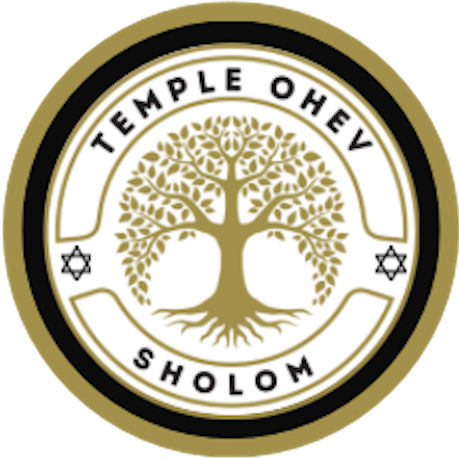Temple Ohev Sholom’s Mission, Vision, Values & ACTION!
Handouts 2/4/24 (Click here to RSVP)
- THE ROLE OF THE VISION/VALUES AND THEIR LINKAGE TO OBJECTIVE(S) / ACTION(S) / RESOURCE(S)
- WHAT ARE OBJECTIVES?
- WHAT ARE ACTIONS?
- WHAT ARE RESOURCES?
- EXAMPLES FROM OTHER SYNAGOGUES
- RESULTS OF OHEV SHOLOM’S STRATEGIC WORKSHOPS SO FAR
THE ROLE OF THE VISION/VALUES AND THEIR LINKAGE TO OBJECTIVE(S) / ACTION(S) / RESOURCE(S)
- The Vision and Values provide the framework from which to derive the future Objectives. Each Objective statement must be specifically aligned with identified Vision and Value components. (e.g., a Vision and associated Values desiring/advocating life-long learning will require an Objective addressing lifelong learning).
- Each Objective will require the identification of at least one Action(s): things needed to be done that are specifically designed to attain the Objective.
- This Action(s) will need to be Resourced (the means: e.g., people, money, time) to provide the Action(s) the capability to be executed/implemented.
- Each Action(s) and its Resources should be able to attain the Objective within a stated Time Frame (near (0-1 Years)/mid (1-3 years)/long term(3-5 years).
- There should be an alignment between each of these statements (VISION/VALUES to OBJECTIVE(S) to ACTION(S) to RESOURCES)
- DEFINITION: Objectives are broad statements of direction that create a bridge from the vision to the objectives. Objectives should support the overall vision.
- Ideally, objectives should be broad, long-term statements (1-5 years) that address the core functional areas of the organization.
- Objectives are broad, long-term accomplishments for an organization to attain.
- Objectives are specific, measurable, and time-bound targets that an organization sets to achieve its goals.
- The Objectives should be supported by the organization.
- OBJECTIVE CHARACTERISTICS (SMART):
- Specific: Target a specific area for attainment/improvement making the objectives as specific and narrow for effective planning.
- Measurable: Define what evidence you’ll need to prove you’re making progress/success and re-evaluate when necessary.
- Achievable: Make sure you can reasonably attain your objective with the available resources and within a certain timeframe.
- Relevant: Your goals should align with your values and organizational vision.
- Time: Specify when the results can be attained (near, mid, long-term). Set a realistic, ambitious end date for task prioritization and motivation.
- HOW TO WRITE AN OBJECTIVE:
- An action-oriented objective begins with a word such as: improve, increase, reduce, decrease, enhance, strengthen, grow – reflecting the desired end state and positioning the quantifying element of the objective.
- Follow the “Verb/ Adjective/ Noun” format. This will create an action statement.
- Objective statements clarify intent. A 3-5 word strategic objective won’t suffice for those who are not present or a member of leadership. Objective statements, 2-3 sentences each, clarify the intent and meaning.
- For example, if the objective is “Increase event-driven fundraising,” the objective statement might be: “Develop a world-class website that makes it easy for donors by partnering with an outside web development firm.”
- The objective statement should describe what the objective means.
- Every objective must have at least a verb and a noun:
- Good: “Improve or increase fundraising so that…” / Bad: “Fundraising”
- DEFINITION: A sequence of activities that an individual or organization would follow to achieve an objective. Steps planned to take to attain the objective. The activities should be concrete and comprehensive, and each action should explain:
- What will occur?
- How much, or to what extent, these actions will occur?
- Who will carry out these actions?
- When these actions will take place, and for how long?
- DEFINITION: Inputs required to execute the plan, such as people, time, and funds. Resource constraint should be considered to ensure that actions are not delayed or compromised. Each resource decision should address:
- What resources (such as money and staff) are needed to carry out the proposed actions.
- Sufficient money to carry out proposed actions. The potential for grants should be considered.
- Availability of personnel to implement the actions. Include addressal for the potential of more manpower to be obtained.
- Ensure there is enough time to carry out the changes. Specify when the results can be attained (near, mid, long-term). Set a realistic, ambitious end date for task conclusion.
COMPREHENSIVE EXAMPLES FROM OTHER SYNAGOGUES DESIGNED FOR APPLICABILITY TO OUR VISION
(Worship/Education/Social Engagement/Tikkun Olam):
VISION: Worship
- OBJECTIVES:
- Inspire members to deepen their involvement with Judaism by attending, contributing to or participating in, Synagogue services and programs
- Increase our members’ connections to the community and Judaism via involvement in Synagogue programs
- ACTIONS:
- Create an active, reflective, and personal component to Jewish experiences, enabling people to share their stories and connect on a personal level with other participants.
- Invite congregants to propose topics/activities that interest them to influence the worship offerings.
- Invite people to learn more about and take an active role in ritual (whether within or outside Temple _____) and encourage them to expand and deepen their participation as they become more comfortable.
- Engage congregants in ongoing reflective conversations about what experiences are meaningful and powerful to them.
- RESOURCES: Committee / TIME FRAME: Near, Medium and Long Terms
VISION: Education/Life-Long Learning:
- OBJECTIVES:
- Consolidate educational strategies at Temple __________to address the range of needs of congregants from birth to senior years.
- Develop ways to give people access to Jewish tools for navigating life.
- Coordinate across educational offerings to maximize logistical efficiencies and build greater engagement.
- Provide engaging learning opportunities for all ages, with no gaps, to help build the “habit” of education
- ACTIONS:
- Create a framework and toolkit for developing new educational programming.
- Complete best practices assessment of current educational programming and support structures.
- Develop a system for evaluating programming.
- Coordinate intercommunity partnerships with other organizations in which can provide additional educational opportunities for the congregation.
- Establish an annual learning theme that can be woven throughout the activities and communications of the synagogue to help everyone have a shared learning path.
- Invest in creating opportunities for “applied Jewish wisdom,” such as small groups on caring for elderly family members or parenting teenagers, where Jewish learning and wisdom can be woven into the content and rhythm of the group. Provide professional support and/or online resources for lay-led groups as needed.
- Invite congregants to propose topics/activities that interest them to influence the menu of educational offerings.
- Integrate Jewish learning into small group experiences in a variety of ways.
- RESOURCES: Education Committee; TIME FRAME: Short and Medium terms
VISION: Social Engagement
- OBJECTIVE:
- Increase membership, engagement and activity by actively welcoming new congregants and integrate them into the fabric of _______.
- Instill a sense of congregation ownership among the synagogue’s members – to inspire greater individual responsibility for their own Jewish journey
- ACTIONS:
- Design and implement a new congregant welcoming process that covers the first two to three years that will (i) enable us to get to know them and their interests; (ii) connect them with other people/families with similar interests (e.g., same age kids, same neighborhood, same hobbies, etc.); and (iii) connect them with relevant opportunities to become more involved in community activities.
- Publicize new member activities in multiple ways, ranging from social media to personal invitations.
- Track new member participation in various activities and reach out proactively if low level of engagement.
- Create a new member guide to TBA with information about whom to contact, how to get involved, etc., and make it easily available in multiple formats (hard copy and online).
- RESOURCES: Committee / TIME FRAME: Near term (within one year)
VISION: Tikkun Olam:
- OBJECTIVES:
- Enhance our Tikkun Olam work – whether direct service or advocacy – by opportunities for congregant involvement and expression of Jewish values.
- Create an integrated plan for Tikkun Olam throughout the year (and across the years), to make the Temple the place for members to turn to exercise their social responsibility according to Jewish tradition
- ACTIONS:
- Establish a structure to coordinate current and emerging Tikkun Olam activities so that they are aligned with the priorities of this strategic plan, and so that Tikkun Olam remains a defining attribute of our community.
- Manage Tikkun Olam activities to maximize opportunities for involvement by congregants who are seeking places to “plug in” in ways that are meaningful to them.
- Use the small group framework described in section III below to guide the structure of Tikkun Olam project groups.
- Build relationships with other local communities to create opportunities for people to engage in Tikkun Olam within the communities where they live and work, and to deepen our understanding and support of marginalized communities.
- RESOURCES: Committee / TIME FRAME: Near Term (one year)
Results of Strategic Workshops
Vision Statement
Temple Ohev Sholom strives to be an inclusive Reform Congregation to serve the evolving needs of Jewish Life in Central Pennsylvania for current and future generations. Our Community will empower all people to create and to sustain a meaningful relationship to Judaism through worship, education, social engagement and tikkun olam.
Mission Statement
Founded in 1853 and the oldest synagogue in Harrisburg, Temple Ohev Sholom is a diverse and inclusive Reform Jewish Congregation in Central Pennsylvania. We support one another throughout the cycles of life. We foster and encourage spiritual growth, lifelong learning, social opportunities and connections and tikkun olam—healing the world.
Core Values
As Harrisburg’s oldest synagogue and only Reform Congregation, Ohev Sholom Synagogue espouses and commits to these five Core Values:
- Honoring our Jewish heritage for today and for the future
- A congregational culture of belonging
- Inclusivity and diversity
- Tikkun Olam– healing the world
- Lifelong learning
-
- gathering in worship that is rooted in Jewish tradition and enhanced with contemporary prayer, music, art, and teaching;
- creating inspiring worship experiences that enrich our spiritual lives both personally and communally;
- communicating and modeling the vision that the Jewish people (here, in Israel, and throughout the world) will live in peace and security with our neighbors;
- enabling congregants to feel pride in being part of a Jewish community and to engage Jewish values to shape their lives, actions, and commitments;
- empowering congregants to access Jewish tradition and to navigate their own Jewish paths;
- ensuring an authentic way to be a Reform Jew in the Greater Harrisburg community; and
- offering a safe place to be a Jew.
-
- prioritizing a sense of “belonging” within a congregation that knows each member personally, building deep and enduring friendships;
- ensuring that congregants of all ages feel a connection to the Temple and its clergy as their spiritual home;
- offering meaningful opportunities for all age groups to socialize, engage and connect within our community;
- supporting one another in times of joy, in times of need, and moments in between; and
- sustaining a culture of respect among clergy, staff, and lay leaders.
-
- welcoming all people into Ohev Sholom;
- encouraging participation from all who seek a connection to Jewish life regardless of religious background or expression of faith, race, ethnicity, gender, gender identity, ability, age, sexual orientation, socioeconomic status, or political affiliation;
- engaging non-Jewish spouses and partners and relatives of our Jewish members in congregational life and worship.
- promoting dignity in programming and in action; and
- offering a safe and accessible place to worship and to be Jewish.
-
- focusing on acts of kindness inside the Synagogue and out;
- caring for the Greater Harrisburg Community via active involvement;
- combating antisemitism through education and activism; and
- fighting for justice, sustenance, and dignity for all people.
-
- delivering engaging educational opportunities that are meaningful and relevant for congregants at each stage of life;
- providing opportunities to exchange ideas and gain new insights and perspectives;
- interpreting traditions through the lens of our changing world; and
- serving as a resource for non-Jews to learn about Judaism.

